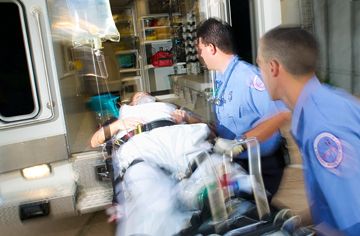New York Coverdell Program Partners with EMS to Improve Stroke Data and Patient Care
Success Story from the Paul Coverdell National Acute Stroke Program
Overview

New York State has the lowest death rate from stroke in the United States. However, because the state has a large population, the actual number of deaths in 2018 was the sixth highest in the nation.1
State officials recognized that reducing stroke deaths meant improving patient care from the time the ambulance first reaches the patient. They created a team to identify key data that emergency medical services (EMS) personnel should collect and report to emergency department staff before stroke patients arrive at a hospital. Receiving the data before arrival helps ensure timely and effective treatment of patients.
These efforts were led by the New York State Coverdell Stroke Quality Improvement and Registry Program (NYS Coverdell Program) and the New York State Department of Health’s Bureau of Emergency Medical Services (Bureau of EMS).
Challenge and Approach
When a person has a stroke, EMS personnel assess their symptoms to determine what emergency treatment they need and where to transport them. This assessment includes key stroke data elements, such as the time at which the patient was “last known well,” and scores on prehospital screening tools called stroke scales.
Over the last decade, key stroke data elements were not included in the national database used to gather and store EMS data, the National Emergency Medical Services Information System (NEMSIS) 2.0.2 To fill this gap in data, staff in the NYS Coverdell Program worked with the Bureau of EMS to ensure that an updated version of the system, called NEMSIS 3.4, would include stroke data elements in the prehospital data fields. The team also assigned validation scores to key stroke data elements to help improve documentation by EMS personnel. Staff in the Bureau of EMS met with regional EMS program agencies to share a “data dictionary,” which contains information about the new data elements. The Bureau of EMS also discussed potential barriers before releasing the new system.
For EMS personnel, adopting a new system and collecting more data elements was a challenge. During the transition period, staff in the NYS Coverdell Program met weekly with the Bureau of EMS, regional EMS program agencies, and the software vendors to address problems. Ongoing communication with key partners was critical to sustaining support for the new system.
The Bureau of EMS rolled out the new data system to one vendor at a time (and to all ambulance services using that vendor), starting with the largest vendor in the state. This approach ensured that the state database included EMS data from all vendors and EMS program agencies in New York.
Accomplishments
During 2018–2019, more than 691 ambulance services across New York State moved from NEMSIS 2.0 to 3.4. The Bureau of EMS held weekly webinars with regional EMS program agencies to build relationships and improve the quality of stroke care across the state. During the webinars, EMS program agencies were able to identify problems and solutions.
As a result of these efforts, the percentage of prehospital stroke screening performed by EMS personnel in New York increased from 32% in the second quarter of 2018 to 57% in the second quarter of 2019. EMS personnel’s documentation of the data element “time last known well” also improved, from 34% in the second quarter of 2018 to 45% in the second quarter of 2019.
Lessons Learned
Adopting NEMSIS 3.4 was challenging for EMS personnel. But several factors helped make the NYS Coverdell Program’s efforts a success:
- Regional EMS program agencies helped provide training and technical assistance on the new system. They also served as liaisons between EMS personnel and the state.
- Weekly conference calls with the Bureau of EMS, regional EMS program agencies, the state health department, and software vendors allowed the group to share any concerns and address problems quickly.
- Weekly communication with key partners provided necessary support during the transition period. Ongoing communication will ensure that the state’s data system continues to improve.
- Partnering with the Bureau of EMS and EMS program agencies to review hospital data and identify gaps between prehospital and in-hospital data systems was key to improving data quality.
Next Steps

The NYS Coverdell Program continues to work to improve stroke care for New York residents. For example, the program has:
- Pilot-tested quality improvement initiatives in two areas of the state. These initiatives were designed to improve the completeness of EMS data, transfer of EMS data to hospitals, and communication between EMS personnel and hospitals. The resulting data will be compared with the data collected in areas of the state not involved in the pilot study.
- Worked with the Bureau of EMS to update the state’s protocols for basic life support and advanced life support for stroke patients to ensure that the protocols align with the data collected in the current data system.
The NYS Coverdell Program also plans to:
- Continue its partnership with the Bureau of EMS and stay involved with future software updates to ensure that key stroke data elements are collected across the state.
- Continue monitoring data from prehospital and in-hospital sources to track improvements in key measures such as when the patient was “last known well.”
For states that decide to conduct similar projects, the NYS Coverdell Program recommends partnering with state EMS program agencies to review their current systems to see whether key stroke data elements are already being collected. The program also recommends involving all affected partners before implementing a new system and maintaining ongoing communication to give partners a way to voice concerns and discuss solutions.
Additional Information
- CDC: Paul Coverdell National Acute Stroke Program
- New York State Coverdell Stroke Quality Improvement and Registry Program
Reference
- Centers for Disease Control and Prevention. Stroke Mortality by State. Accessed August 25, 2020.
- National Emergency Medical Services Information System. What Is NEMSIS? Accessed August 26, 2020.
